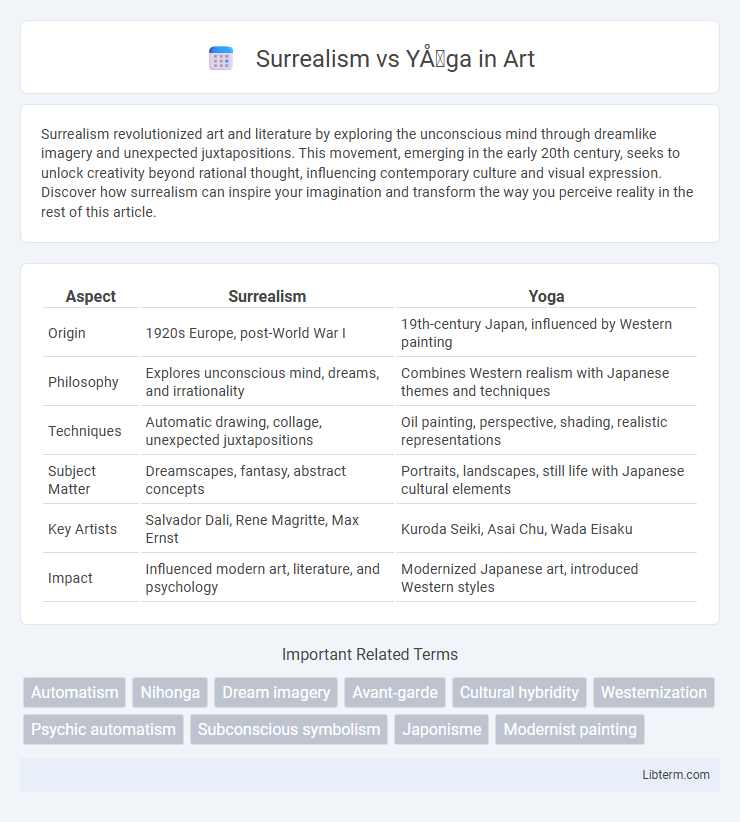Surrealism revolutionized art and literature by exploring the unconscious mind through dreamlike imagery and unexpected juxtapositions. This movement, emerging in the early 20th century, seeks to unlock creativity beyond rational thought, influencing contemporary culture and visual expression. Discover how surrealism can inspire your imagination and transform the way you perceive reality in the rest of this article.
Table of Comparison
| Aspect | Surrealism | Yoga |
|---|---|---|
| Origin | 1920s Europe, post-World War I | 19th-century Japan, influenced by Western painting |
| Philosophy | Explores unconscious mind, dreams, and irrationality | Combines Western realism with Japanese themes and techniques |
| Techniques | Automatic drawing, collage, unexpected juxtapositions | Oil painting, perspective, shading, realistic representations |
| Subject Matter | Dreamscapes, fantasy, abstract concepts | Portraits, landscapes, still life with Japanese cultural elements |
| Key Artists | Salvador Dali, Rene Magritte, Max Ernst | Kuroda Seiki, Asai Chu, Wada Eisaku |
| Impact | Influenced modern art, literature, and psychology | Modernized Japanese art, introduced Western styles |
Introduction to Surrealism and Yōga
Surrealism, an influential 20th-century art movement originating in Europe, emphasizes the exploration of the unconscious mind through dream-like, fantastical imagery and unexpected juxtapositions. Yoga, a genre of Japanese painting developed during the Meiji period, incorporates Western techniques such as realism, perspective, and oil painting while maintaining traditional Japanese themes. Both Surrealism and Yoga challenge conventional aesthetics but differ in their cultural roots and artistic objectives, with Surrealism focusing on psychological depth and Yoga on synthesizing Eastern and Western art forms.
Historical Origins and Development
Surrealism emerged in the early 1920s as an avant-garde movement rooted in the Dada movement and strongly influenced by Sigmund Freud's theories of the unconscious mind. Yoga, in contrast, originated in Japan during the late 19th century as a response to Western artistic techniques and perspectives introduced through modernization and Meiji-era reforms. Both movements reflect cultural shifts: Surrealism challenges reality through dreamlike imagery, while Yoga integrates Western realism with traditional Japanese aesthetics to redefine artistic expression.
Key Philosophical Foundations
Surrealism is rooted in the exploration of the unconscious mind, emphasizing dream-like imagery and irrational juxtapositions to unlock hidden desires and fears, heavily influenced by Freudian psychoanalysis. Yoga, or Western-style painting in Japan, prioritizes realistic representation and technical accuracy, grounded in European academic traditions and often reflecting rational observation of the natural world. The philosophical foundation of Surrealism centers on liberating creativity from logical constraints, while Yoga emphasizes disciplined mastery and the pursuit of visual truth through empirical study.
Influential Artists and Works
Surrealism, founded in the early 20th century, features influential artists like Salvador Dali, known for "The Persistence of Memory," and Rene Magritte, creator of "The Treachery of Images," who explored dreamscapes and the unconscious mind. Yoga, a Japanese Western-style painting movement, includes prominent figures such as Kuroda Seiki and Takahashi Yuichi, whose works like "Lakeside" and "Morning Toilette" integrated European techniques with Japanese aesthetics. Both movements reflect deep cultural exchanges, with Surrealism impacting global modern art and Yoga transforming Japanese art by blending traditional themes with Western realism.
Visual Styles and Techniques
Surrealism employs dreamlike imagery, unexpected juxtapositions, and automatic drawing techniques to explore the unconscious mind, often resulting in fantastical and bizarre visual compositions. Yoga, a Japanese Western-style painting movement, incorporates realistic perspectives, precise brushwork, and oil painting methods derived from European traditions, emphasizing naturalistic representation and light effects. While Surrealism leans toward abstract and symbolic content driven by subconscious themes, Yoga focuses on technical mastery and realism within landscapes, portraits, and still life.
Thematic Exploration and Symbolism
Surrealism delves into the unconscious mind, exploring dream imagery and irrational juxtapositions to challenge reality and provoke subconscious revelations. Yoga art emphasizes naturalistic representation and harmony, often drawing from Buddhist and Shinto symbolism to convey spiritual themes and human connection with nature. Both movements employ symbolism, but Surrealism prioritizes psychological depth while Yoga centers on cultural and spiritual narratives.
Cultural Context and Impact
Surrealism emerged in early 20th-century Europe as an avant-garde movement emphasizing the subconscious and dream imagery, profoundly influencing Western art and literature through figures like Andre Breton and Salvador Dali. Yoga, introduced to Japan during the Meiji period, integrated Western oil painting techniques with Japanese aesthetics, reshaping Japan's artistic landscape by blending tradition with modernization. The cultural impact of Surrealism challenged rationalism and conventional norms in the West, while Yoga facilitated cultural exchange and the evolution of modern Japanese art by bridging Eastern and Western art histories.
Surrealism vs Yōga: Points of Convergence
Surrealism and Yoga intersect in their exploration of subconscious and transcendental states, emphasizing dream-like imagery and spiritual awakening respectively. Both movements prioritize intuitive creativity, with Surrealism tapping into the unconscious mind through irrational juxtapositions and Yoga focusing on meditative practices to attain higher consciousness. Their convergence lies in transcending ordinary perception to unlock deeper psychological and spiritual truths.
Critical Reception and Legacy
Surrealism, emerging in the 1920s, received initial critical acclaim for its innovative exploration of the unconscious mind, influencing avant-garde literature and visual arts globally. Yoga, a Western-style painting movement in Japan from the late 19th century, faced mixed reception as traditionalists criticized its departure from native artistic conventions, yet it significantly modernized Japanese art and education. Both movements' legacies endure through their profound impact on contemporary art practices, with Surrealism shaping modernist thought and Yoga bridging Eastern and Western artistic techniques.
Contemporary Interpretations
Contemporary interpretations of Surrealism emphasize its exploration of the unconscious mind through dreamlike imagery and irrational juxtapositions, influencing modern art, literature, and digital media. Yoga, a style of Western-influenced Japanese painting, is reinterpreted today by blending traditional techniques with contemporary themes, reflecting Japan's cultural hybridity and global artistic exchange. Both movements continue to evolve, highlighting the dialogue between cultural identity and artistic innovation in the 21st century.
Surrealism Infographic

 libterm.com
libterm.com